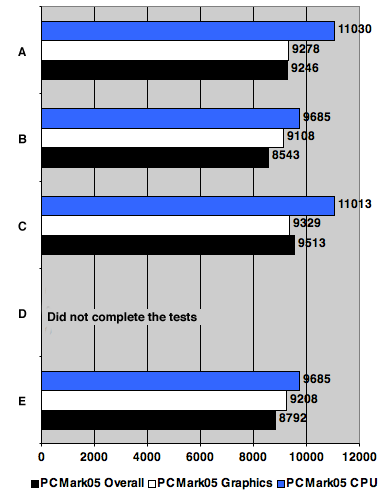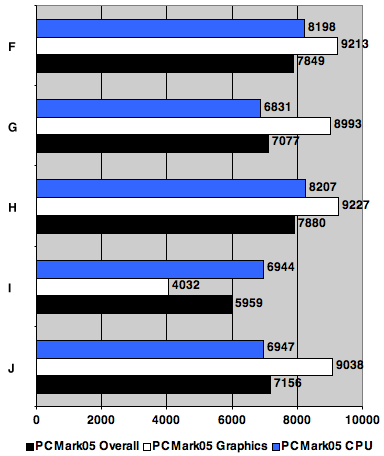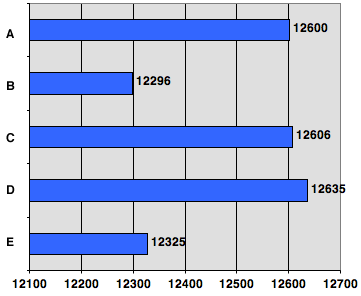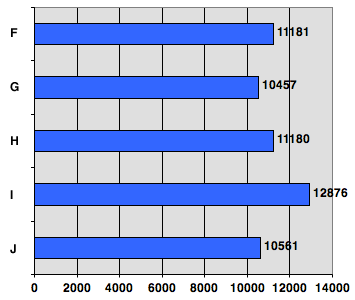This article is more than 1 year old
Asus Maximus Formula Intel X38-based mobo
Maximus or minimus?
Using first a quad core Intel Core 2 Extreme QX6850 processor and then a Core 2 Duo E6700 we found that the Asus out-performed the Gigabyte by a small margin despite the apparent handicap of slower DDR 2 memory. Overclocking the Gigabyte is a simple matter of jacking up the FSB and setting a memory multiplier, but Asus tries to make life even easier. Although the BIOS contains all the usual overclocking features, under the Extreme Tweaker menu it includes a feature called CPU Level Up, which can be set to Auto or Crazy.
PCMark05 Results

Longer bars are better
A. Gigabyte X38T-DQ6, QX6850 at 3.42GHz, OCZ PC3-1600 at 1520MHz, Single HD 2900XT
B. Gigabyte X38T-DQ6, QX6850 at 3.0GHz, OCZ PC3-1600 at 1333MHz, Single HD 2900XT
C. Asus Maximus Formula, QX6850 at 3.41GHz,OCZ Reaper at 1137MHz, Single HD 2900XT
D. Asus Maximus Formula, QX6850 at 3.50GHz,OCZ Reaper at 933MHz, Single HD 2900XT
E. Asus Maximus Formula, QX6850 at 3.0GHz,OCZ Reaper at 1200MHz, Single HD 2900XT

Longer bars are better
F. Gigabyte X38T-DQ6, E6700 at 3.20GHz, OCZ PC3-1600 at 1280MHz, Single HD 2900XT
G. Gigabyte X38T-DQ6, E6700 at 2.67GHz, OCZ PC3-1600 at 1066MHz, Single HD 2900XT
H. Asus Maximus Formula, E6700 at 3.20GHz, OCZ Reaper at 1066MHz, Single HD 2900XT
I. Asus Maximus Formula, E6700 at 2.67GHz, OCZ Reaper at 1200MHz, Dual HD 2900XT in CrossFire
J. Asus Maximus Formula, E6700 at 2.67GHz, OCZ Reaper at 1200MHz, Single HD 2900XT
In this context Crazy means ‘preset profile for your CPU’. However, it was a touch too ambitious for the QX6850, which it tried to run at 3.5GHz causing the system to restart during PCMark05. We manually clocked to 3.41GHz and once again got marginally higher performance with the Asus than we did with the Gigabyte.
3DMark06 Results

Longer bars are better
A. Gigabyte X38T-DQ6, QX6850 at 3.42GHz, OCZ PC3-1600 at 1520MHz, Single HD 2900XT
B. Gigabyte X38T-DQ6, QX6850 at 3.0GHz, OCZ PC3-1600 at 1333MHz, Single HD 2900XT
C. Asus Maximus Formula, QX6850 at 3.41GHz,OCZ Reaper at 1137MHz, Single HD 2900XT
D. Asus Maximus Formula, QX6850 at 3.50GHz,OCZ Reaper at 933MHz, Single HD 2900XT
E. Asus Maximus Formula, QX6850 at 3.0GHz,OCZ Reaper at 1200MHz, Single HD 2900XT

Longer bars are better
F. Gigabyte X38T-DQ6, E6700 at 3.20GHz, OCZ PC3-1600 at 1280MHz, Single HD 2900XT
G. Gigabyte X38T-DQ6, E6700 at 2.67GHz, OCZ PC3-1600 at 1066MHz, Single HD 2900XT
H. Asus Maximus Formula, E6700 at 3.20GHz, OCZ Reaper at 1066MHz, Single HD 2900XT
I. Asus Maximus Formula, E6700 at 2.67GHz, OCZ Reaper at 1200MHz, Dual HD 2900XT in CrossFire
J. Asus Maximus Formula, E6700 at 2.67GHz, OCZ Reaper at 1200MHz, Single HD 2900XT
3DMark06 responds enthusiastically to CrossFire and returned some enormous scores, but PCMark05 threw up an oddity as it shows performance with two HD 2900XT graphics cards is substantially lower than a single HD 2900XT, which is clearly nonsense. We’ve included one set of CrossFire figures to illustrate this point.
Verdict
Asus has used Intel's X38 chipset in a superb Core 2 Duo motherboard that delivers the goods, albeit at a relatively steep price. We suggest that you ignore CrossFire and instead dwell on the extensive list of features, the use of affordable DDR 2 memory, and support for Penryn and a 1600MHz FSB.

